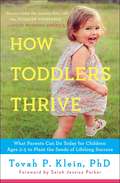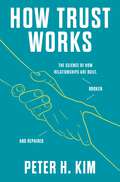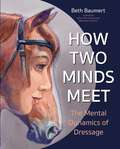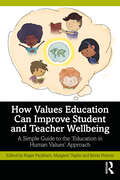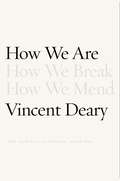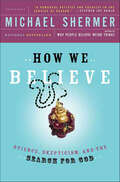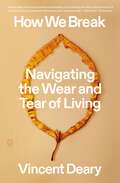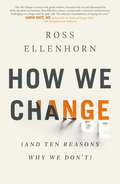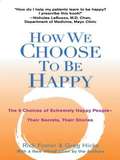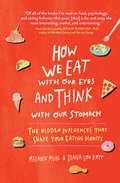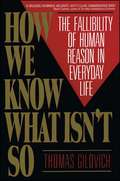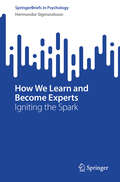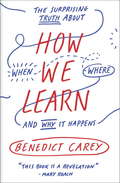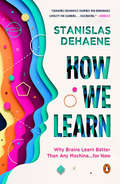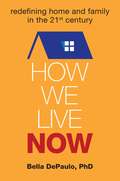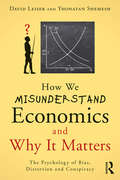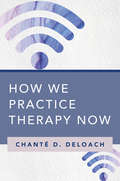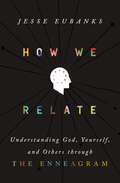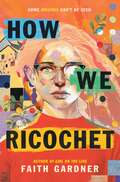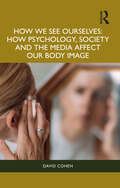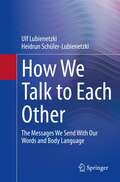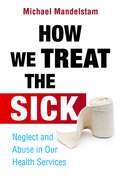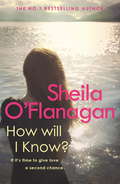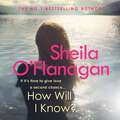- Table View
- List View
How Toddlers Thrive: What Parents Can Do Today for Children Ages 2-5 to Plant the Seeds of Lifelong Success
by Tovah P KleinFrom child development psychologist and parenting expert Dr. Tovah Klein—called &“the toddler whisperer&” by Good Morning America—comes a lively and revelatory book that will teach parents of children ages two to five how to harness the singular power of the toddler mind, plant the seeds of lifelong success, and lessen struggles around bedtime, eating, tantrums, and more.Why do some children thrive, and others struggle? The answers may surprise you. New research indicates that the seeds for adult success are actually planted in the toddler years. Dr. Tovah Klein’s research and firsthand work with thousands of toddlers explains why the toddler brain is best suited to laying the foundation for success. Dr. Klein reveals the new science behind drivers such as resilience, self-reliance, self-regulation, and empathy that are more critical to success than simple intelligence. She explains what you can do today to instill these key qualities in your toddler during this crucial time, so they are on track and ready to learn when they enter school at age five. How Toddlers Thrive explains why the toddler years are different than any other period during childhood. She shows what is happening in children’s brains and bodies at this age that makes their behavior so turbulent, and why your reaction to their behavior—the way you speak to, speak about, and act toward your toddler—holds the key to a successful tomorrow and a happier today. This provocative book will inspire you to be a better parent, and give you the tools to help you nurture your child’s full potential. A smart and useful guide, this book cracks the preschooler code, revealing what you can do to help your toddler grow into a fulfilled child and adult—while helping you and your toddler live more happily together now, and every day.
How Trust Works: The Science of How Relationships Are Built, Broken, and Repaired
by Dr. Peter H. KimFrom the world's leading expert on trust repair, a guide to understanding the most essential foundation of our relationships and communities.When our trust is broken, and when our own trustworthiness is called into question, many of us are left wondering what to do. We barely know how trust works. How could we possibly repair it?Dr. Peter H. Kim, the world’s leading expert in the rapidly growing field of trust repair, has conducted over two decades of groundbreaking research to answer that question. In How Trust Works, he draws on this research and the work of other social scientists to reveal the surprising truths about how relationships are built, how they are broken, and how they are repaired. Dr. Kim’s work shows how we are often more trusting than we think and how easily our trust in others can be distorted. He illustrates these insights with accounts of some of the most striking and well-known trust violations that have occurred in modern times and unveils the crucial secrets behind when and why our attempts to repair trust are effective, and which breaches of confidence are just too deep.How Trust Works transforms our understanding of our deepest bonds, giving us the tools to build strong and supportive relationships on every level. With our families, coworkers, and friends. With the groups, organizations, and institutions that touch our lives. And even with societies and nations.
How Two Minds Meet
by Beth BaumertAn exciting follow-up to the bestselling bookWhen Two Spines Align: Dressage Dynamics.Beth Baumert's first book,When Two Spines Align: Dressage Dynamics,was a popular and critical success. Lauded by Olympian Carl Hester as the book he most frequently quotes at clinics, it examined the ways thephysicalbodies of horse and rider work together—the physics behind riding in balance. In Baumert's new bookHow Two Minds Meet,she takes us beyond physical harmony to look at the minds of both horse and rider, each complete with its own set of emotions and mental capabilities. Readers will explore:How the mind of the horse works.the rider's &“two minds&”—the analytical mind and the sensory dimension of the mind (with which the horse more readily identifies).Specific ways to get into the &“non-thinking place&” where the best communication between horse and rider takes place.Principles of Learning that enable riders to improve the use of the traditional, knowledge—accumulating part of their brains.Nine ideas for boosting your ability to learn, retain, and apply knowledge that's useful in training horses.Methods for organizing and &“filing&” information so it can be best utilized.How to ensure the horse is physically comfortable (balanced) under saddle to allow for a meeting of the minds in the first place.Not only does Baumert explain how to optimize the use of the &“thinking mind&” in order to become a better learner in the saddle, she provides techniques for maximizing mental and emotional harmony with the horse, a state of unity that feels so good, Baumert calls it the &“charming addiction&”—once a rider has it, she wants to attain it again and again. Feeding this addiction is possible, says Baumert, with the thoughtful, practical insight she shares in these pages.
How Values Education Can Improve Student and Teacher Wellbeing: A Simple Guide to the ‘Education in Human Values’ Approach
by Margaret Taplin Roger Packham Kevin FrancisPresenting Values Education as a solution to major challenges in education such as student disengagement and teacher burnout, this book provides a wealth of practical advice about how to implement the Education in Human Values approach in schools, promoting wellness and improved educational outcomes.Values Education is a world-wide movement and comes in several forms. This book explains the need for and nature of values education, provides practical, easy strategies for implementing the Education in Human Values (EHV) approach, and outlines the educational theories that underpin it. The practical strategies in this book can be implemented in small increments in all aspects of school life. The focus is on both student and teacher wellbeing. The methods can also be used by teachers to address their own professional and personal challenges and to help them cope with difficult situations that cannot be changed.Written for teachers, teacher educators, and teachers in training, this book is the one-stop-shop for gaining a better understanding of values education, how it can support whole-school wellbeing and how to implement it effectively.
How We Are
by Vincent DearyThe first book in a major new trilogy, How to Live: How We Are, How We Break, and How We MendWe live in small worlds. How We Are is an astonishing debut and the first part of the monumental How to Live trilogy, a profound and ambitious work that gets to the heart of what it means to be human: how we are, how we break, and how we mend. In Book One, How We Are, we explore the power of habit and the difficulty of change. As Vincent Deary shows us, we live most of our lives automatically, in small worlds of comfortable routine--what he calls Act One. Conscious change requires deliberate effort, so for the most part we avoid it. But inevitably, from within or without, something comes along to disturb our small worlds--some News from Elsewhere. And with reluctance, we begin the work of adjustment: Act Two. Over decades of psychotherapeutic work, Deary has witnessed the theater of change--how ordinary people get stuck, struggle with new circumstances, and finally transform for the better. He is keenly aware that novelists, poets, philosophers, and theologians have grappled with these experiences for far longer than psychologists. Drawing on his own personal experience and a staggering range of literary, philosophical, and cultural sources, Deary has produced a mesmerizing and universal portrait of the human condition. Part psychologist, part philosopher, part novelist, Deary helps us to see how we can resist being habit machines, and make our acts and our lives more fully our own.
How We Believe: Science, Skepticism, and the Search for God
by Michael ShermerA new edition covering the latest scientific research on how the brain makes us believers or skepticsRecent polls report that 96 percent of Americans believe in God, and 73 percent believe that angels regularly visit Earth. Why is this? Why, despite the rise of science, technology, and secular education, are people turning to religion in greater numbers than ever before? Why do people believe in God at all? These provocative questions lie at the heart of How We Believe , an illuminating study of God, faith, and religion. Bestselling author Michael Shermer offers fresh and often startling insights into age-old questions, including how and why humans put their faith in a higher power, even in the face of scientific skepticism. Shermer has updated the book to explore the latest research and theories of psychiatrists, neuroscientists, epidemiologists, and philosophers, as well as the role of faith in our increasingly diverse modern world.Whether believers or nonbelievers, we are all driven by the need to understand the universe and our place in it. How We Believe is a brilliant scientific tour of this ancient and mysterious desire.
How We Break: Navigating the Wear and Tear of Living (How to Live Series #2)
by Vincent DearyDrawing on cutting-edge science and intimate personal stories, an essential and paradigm-shifting book for readers struggling with fatigue, burnout, stress, and trauma—and for all of us who sometimes feel like we have been pushed past our breaking point.In How We Are, the health psychologist and author Vincent Deary explored the process of habit and change in everyday life. In How We Break, a deeply compassionate and illuminating exploration of suffering, he examines what happens when we are pushed to our limit. Deary is a practitioner health psychologist who also works in a fatigue clinic and specializes in interventions that help people cope with whatever life has thrown at them. The big traumas in life, he points out, are relatively rare. Much more common is when too many things go wrong at once, or we are exposed to a prolonged period of difficulty or precarity. When we are subjected to too much turbulence—when the world shrinks to nothing but our daily coping—we become unhappy, worried, hopeless, exhausted. In other words, we break. Breaking, he shows us, is embodied, as our physical and mental distress are linked, and happens when the same systems that enable us to navigate through life become dysregulated. But if we understand how the turbulence and overwhelm of life affects us, then we have a better chance of overcoming the challenges. Drawing on clinical case studies, trailblazing scientific research, intimate personal stories, and illuminating references from philosophy, literature, and film, How We Break offers a consoling and deeply felt new vision of everyday human struggling, and it makes a bold case for the power of rest and recuperation.
How We Change (and 10 Reasons Why We Don't): (and Ten Reasons Why We Don't)
by Dr Ross EllenhornA paradigm-shifting, instant classic in the making that challenges our assumptions about change by encouraging us to understand and embrace our resistance to it.We all have something we want to change about ourselves. But whether it's quitting smoking, losing weight, or breaking some common bad habit or negative behaviour pattern, we feel a sense of failure when we don't succeed. This often sets off a cascade of negative feelings and discouragement, making it even harder to change. The voice in our head tells us: Why bother?Successful change depends far more on understanding why we don't change, psychotherapist and sociologist Ross Ellenhorn insists. His decades-long career as a pioneer in helping people overcome extreme psychiatric experiences and problematic substance use issues - especially those whom the behavioural healthcare system has failed - especially those whom the mental healthcare system has failed - has lead him to develop an effective, long-term method to achieve transformation, from the simplest shifts to the most profound. In How We Change, Ellenhorn looks to the evolutionary imperatives driving us. We are wired to double down on the familiar because of what he calls the Fear of Hope - the act of protecting ourselves from further disappointment. He identifies the '10 Reasons Not to Change' to help us see why we behave the way we do, making it clear that there is nothing broken inside us - it's how we're built. By addressing this little known reality, he gives us hope and helps us work toward the change we seek. Ellenhorn speaks to the core of our insecurities and fears about ourselves, with a humour and kindness. By turning our judgements about self-destructive behaviours into curious questions about them, he teaches us to think about our actions to discover what we truly want - even if we're going about getting it in the wrong way. How We Change is a brilliant approach that will forever alter our perspective and help us achieve the transformation we truly seek.
How We Choose to Be Happy
by Rick FosterWhat does it mean to be truly happy? Is there a secret to happiness?To most people it is self-evident--the secret to true happiness is not found in riches, things, or events. The source of happiness, as revealed in this insightful, inspiring, and infinitely practical book, is to be found in the way we choose to live our lives. Truly happy people make conscious decisions about how they will confront all of life's challenges. In the face of sometimes overwhelming circumstances, they create happiness by making the same nine internal, principle-centered choices. The people whose stories illuminate this book, representing a wide range of ages, and economic, social, political, and religious backgrounds, all make an active commitment to be happy. They are accountable for their own actions, thoughts, and feelings. They identify what makes them happy and make it central to their lives. Happy people find meaning and emotional energy in every event. They are flexible and open to life's many options. They appreciate what they have, and give unceasingly with no expectation of a "return. " Happy people are truthful with themselves and others. How We Choose to Be Happy explores the nine choices that extremely happy people make, and shows how anyone can follow these tenets to create a unique personal experience.
How We Eat with Our Eyes and Think with Our Stomach: The Hidden Influences That Shape Your Eating Habits
by Brian Wansink Carolin Sommer Melanie Mühl Diana Von Kopp“Cut through the juice cleanses and paleo diets to bring back some common sense.”—The New York Times Book ReviewOutsmart Your Impulses and Eat Better A Belgian chocolate cake topped with a velvety homemade mousse catches your eye on the menu. The next thing you know, you’ve ordered it—despite the hefty price. But do you know why? Through over 40 compelling questions, this book explores how our eating decisions tread the line between conscious and subconscious, and enables us to be more intelligent about food. With expert insights that draw from psychology, neuroscience, popular culture, and more, learn to see the innumerable influences behind your diet and cravings—from the size and color of your plate, to the placement of products in a supermarket, to the order in which you sit when out with friends. And the chocolate cake? Would you believe research shows that regional descriptions (Belgian!) and emotive, sensory language (homemade! velvety!) subtly affect your appetite? Know what and why you eat, when and how you do—before you next sit down to dine!
How We Know What Isn't So: The Fallibility Of Human Reason In Everyday Life
by Thomas GilovichGilovich illustrates his points with vivid examples and supports them with the latest research findings in a wise and readable guide to the fallacy of the obvious in everyday life.
How We Learn and Become Experts: Igniting the Spark (SpringerBriefs in Psychology)
by Hermundur SigmundssonThis book explores how we learn new skills and knowledge. The book also focuses on how we become experts. Currently, there is an understanding that experts and expertise are made, and thus, deliberate practice and follow-up are needed over time to excel over the years. This volume will also analyze which factors may be important to be able to train your brain and behavior to develop expertise. Passion may be one such factor; others may be grit and a growth mindset.
How We Learn: The Surprising Truth About When, Where, and Why It Happens
by Benedict CareyIn the tradition of The Power of Habit and Thinking, Fast and Slow comes a practical, playful, and endlessly fascinating guide to what we really know about learning and memory today--and how we can apply it to our own lives. From an early age, it is drilled into our heads: Restlessness, distraction, and ignorance are the enemies of success. We're told that learning is all self-discipline, that we must confine ourselves to designated study areas, turn off the music, and maintain a strict ritual if we want to ace that test, memorize that presentation, or nail that piano recital. But what if almost everything we were told about learning is wrong? And what if there was a way to achieve more with less effort? In How We Learn, award-winning science reporter Benedict Carey sifts through decades of education research and landmark studies to uncover the truth about how our brains absorb and retain information. What he discovers is that, from the moment we are born, we are all learning quickly, efficiently, and automatically; but in our zeal to systematize the process we have ignored valuable, naturally enjoyable learning tools like forgetting, sleeping, and daydreaming. Is a dedicated desk in a quiet room really the best way to study? Can altering your routine improve your recall? Are there times when distraction is good? Is repetition necessary? Carey's search for answers to these questions yields a wealth of strategies that make learning more a part of our everyday lives--and less of a chore. By road testing many of the counterintuitive techniques described in this book, Carey shows how we can flex the neural muscles that make deep learning possible. Along the way he reveals why teachers should give final exams on the first day of class, why it's wise to interleave subjects and concepts when learning any new skill, and when it's smarter to stay up late prepping for that presentation than to rise early for one last cram session. And if this requires some suspension of disbelief, that's because the research defies what we've been told, throughout our lives, about how best to learn. The brain is not like a muscle, at least not in any straightforward sense. It is something else altogether, sensitive to mood, to timing, to circadian rhythms, as well as to location and environment. It doesn't take orders well, to put it mildly. If the brain is a learning machine, then it is an eccentric one. In How We Learn, Benedict Carey shows us how to exploit its quirks to our advantage.
How We Learn: Why Brains Learn Better Than Any Machine . . . for Now
by Stanislas DehaeneAn illuminating dive into the latest science on our brain's remarkable learning abilities and the potential of the machines we program to imitate themThe human brain is an extraordinary machine. Its ability to process information and adapt to circumstances by reprogramming itself is unparalleled and it remains the best source of inspiration for recent developments in artificial intelligence. In How We Learn, Stanislas Dehaene decodes the brain's biological mechanisms, delving into the neuronal, synaptic, and molecular processes taking place. He explains why youth is such a sensitive period, during which brain plasticity is maximal, but assures us that our abilities continue into adulthood and that we can enhance our learning and memory at any age. We can all learn to learn by taking maximal advantage of the four pillars of the brain's learning algorithm: attention, active engagement, error feedback, and consolidation.The exciting advancements in artificial intelligence of the last twenty years reveal just as much about our remarkable abilities as they do about the potential of machines. How We Learn finds the boundary of computer science, neurobiology, and cognitive psychology to explain how learning really works and how to make the best use of the brain's learning algorithms, in our schools and universities, as well as in everyday life.
How We Live Now
by Bella DepauloA close-up examination and exploration, How We Live Now challenges our old concepts of what it means to be a family and have a home, opening the door to the many diverse and thriving experiments of living in twenty-first century America.Across America and around the world, in cities and suburbs and small towns, people from all walks of life are redefining our "lifespaces"--the way we live and who we live with. The traditional nuclear family in their single-family home on a suburban lot has lost its place of prominence in contemporary life. Today, Americans have more choices than ever before in creating new ways to live and meet their personal needs and desires. Social scientist, researcher, and writer Bella DePaulo has traveled across America to interview people experimenting with the paradigm of how we live. In How We Live Now, she explores everything from multi-generational homes to cohousing communities where one's "family" is made up of friends and neighbors to couples "living apart together" to single-living, and ultimately uncovers a pioneering landscape for living that throws the old blueprint out the window. Through personal interviews and stories, media accounts, and in-depth research, How We Live Now explores thriving lifespaces, and offers the reader choices that are freer, more diverse, and more attuned to our modern needs for the twenty-first century and beyond.
How We Misunderstand Economics and Why it Matters: The Psychology of Bias, Distortion and Conspiracy
by David Leiser Yhonatan ShemeshThis is the first book to explain why people misunderstand economics. From the cognitive shortcuts we use to make sense of complex information, to the metaphors we rely on and their effect on our thinking, this important book lays bare not only the psychological traits that distort our ability to understand such a vital topic, but also what this means for policy makers and civil society more widely. Accessibly written, the book explores the mismatch between the complexities of economics and the constraints of human cognition that lie at the root of our misconceptions. The authors document and explain the gamut of cognitive strategies laypeople employ as they grapple with such complex topics as inflation, unemployment, economic crises, finance, and money in the modern economy. The book examines sources of misconceptions ranging from the intentionality fallacy, whereby economic phenomena are assumed to have been caused deliberately rather than to have come about by an interplay of many agents and causal factors, to the role of ideology in framing economic thinking. Exposing the underlying biases and assumptions that undermine financial and economic literacy, and concluding with recommendations for how policies and ideas should be framed to enable a clearer understanding, this will be essential reading not only for students and researchers across psychology and economics, but also anyone interested in progressive public policy. Visit the associated website for the book here: http://www.misunderstandeconomics.com/
How We Practice Therapy Now
by Chanté D. DeLoachEssential approaches to clinical practice for today’s out-of-office world. Future psychotherapy is not confined to the office: it can be online, virtual, wellness-oriented, flexible, racially conscious, and in service of public wellness. COVID-19 has forever changed the landscape of psychotherapy in these ways, and in ways we have yet to discover. Practicing psychologist Chanté D. DeLoach invites readers to reflect on the state of psychotherapy and emerging potentialities forged through crisis. She presents key concepts of telemental health, concierge therapy, and other out-of-office approaches to psychological well-being. DeLoach provides step-by-step guidance on getting started in telemental health, and points to clinical, ethical, and legal considerations for clinicians working in a digital space and other nontraditional formations. Topics covered include: how to screen clients for the appropriateness of teletherapy; the required equipment and infrastructure, demystifying the different online platforms; ways to set up a warm and inviting online office, and legal and ethical issues of remote therapy. It also considers business and practice management issues such as what to include in an informed consent for teletherapy. Important discussions of race, intersectionality, and justice in teletherapy round out the book. Readers will be invited to critically reflect on their own identities and comfort in integrating the challenging issues of race, power, and privilege in clinical work. Through interwoven examples and reflective exercises, Dr. DeLoach provides tools to support practitioners as they reimagine their clinical identities to meet the needs of today’s clients. This book offers keen insights and learning for all clinicians, from trainees to seasoned practitioners, who are embarking on this new terrain.
How We Relate: Understanding God, Yourself, and Others through the Enneagram
by Jesse EubanksAn Enneagram book like no other, How We Relate helps you discover how God speaks into your unique personality and life story to make the gospel come alive for you. In How We Relate, Enneagram coach and host of The EnneaCast podcast Jesse Eubanks invites you to discover who you are. In this illustrated guide, he expertly utilizes the Enneagram to lead you to the heart of Jesus, where you will find the wholeness you long for. As you peel back the layers of your False Self, encounter Jesus, and experience the redemption of your True Self, you will discover how to:Understand your personality and the personalities of othersExplore your distinct approach to relationshipsDiscover how Jesus empathizes with and heals your unique core woundInterpret the Enneagram through the gospel storyExperience more meaningful relationships with God, others, and yourself Life is about relationships. It's time to transform yours.
How We Ricochet
by Faith GardnerFor readers of This Is How It Ends and All the Bright Places, How We Ricochet takes an intimate and unflinching look into the devastating consequences of a mass shooting for one girl and her close-knit family, from Faith Gardner, acclaimed author of Girl on the Line. It seems sometimes a charade that we continue celebrating in the face of relentless tragedy. How dare we? But then . . . what else is there to do?Betty’s mom needed new pants for her job.That was why Betty was at the mall with her mom and sister when the shooting started.Afterward, nothing is the same.There are no easy answers to be found, and Betty’s search for them leads her to Michael, the brother of the shooter. But this path only shows Betty one thing: that everything she thought she knew—about herself, about the world around her—can change in a heartbeat.A moving, powerful journey of life after tragedy, How We Ricochet is a fearless and necessary story for our time that will resonate with readers everywhere.
How We See Ourselves: How Psychology, Society and the Media Impact our Body Image
by David CohenThis light-hearted and entertaining book, authored by top psychologist David Cohen, explores the influences and impacts on our perception of body image, examining the power of appearance and the psychology behind how we think and feel about ourselves physically.Packed with scientific findings alongside historical anecdotes and humorous insights, the book first looks at the history of body image and appearance, and how ideals of beauty have changed over time. It goes on to note the rise of the beauty and fashion industries, looking at how society, culture and the media can affect body image. The final section deals with issues of body dissatisfaction and the treatments and therapy available for those struggling with body image and mental health. Along the way, readers will meet a cast of characters from Elizabeth I, a daring, medieval Welsh poet, an Egyptian mummy with the first known tattoo, Paul F. Schilder who pioneered the study of body image, and the brave recipients of the first face transplants, among many more.In his trademark engaging style, Cohen offers a rich account of the psychology of body image through the ages and through the lifespan. It is valuable reading for students of psychology and professionals and therapists aiming to promote body positivity.
How We Talk to Each Other - The Messages We Send With Our Words and Body Language: Psychology of Human Communication
by Heidrun Schüler-Lubienetzki Ulf LubienetzkiThis compact textbook introduces you to the psychological basics of human communication of everyday life in an entertaining way. You will encounter groundbreaking concepts, models, and axioms of communication (including well-known names such as Paul Watzlawick and Friedemann Schulz von Thun), different perspectives on communication, and various communication styles and patterns. You will learn what it means to communicate successfully and what makes successful communication difficult or even prevents it. And virtually in passing, you will learn to better understand your own communication and therefore yourself.This book is a translation of the original German 1st edition Was wir uns wie sagen und zeigen by Ulf Lubienetzki, published by Springer-Verlag GmbH Deutschland, ein Teil von Springer Nature in 2020. The translation was done with the help of artificial intelligence (machine translation by the service DeepL.com). A subsequent human revision was done primarily in terms of content, so that the book will read stylistically differently from a conventional translation. Springer Nature works continuously to further the development of tools for the production of books and on the related technologies to support the authors.
How We Treat the Sick
by Michael MandelstamNo official statistics are kept for the number of hospital patients, in particular older people, who are subjected to neglect and abuse. That is, left malnourished and dehydrated, in pain, allowed to develop agonising and fatal pressure sores, not taken to the toilet, left to lie in their own bodily waste, cared for in a filthy environment and at risk of infection, ignored, allowed to fall over repeatedly, not spoken to, left naked or dressed in other patients' clothes - and discharged from hospital prematurely. This book bears witness to all these practices and more. Setting out a wealth of evidence not previously brought together, Michael Mandelstam shows beyond question that neglectful care is a systemic blight, rather than mere local blemish, within our health services. He analyses the causes and factors involved, reveals the widespread denial and lack of accountability on the part of those responsible - and spells out the political, moral, professional and legal implications of this failure to care for the most vulnerable of patients with humanity and compassion. Most important, Mandelstam points to the main obstacles to a solution - and to how they can be removed and change be accomplished. This book should be read by anyone concerned with the state of our health services, including National Health Service users, government policy makers and planners, public health practitioners and academics and researchers.
How Will I Know?: A life-affirming read of love, loss and letting go
by Sheila O'FlanaganSheila O'Flanagan's bestselling HOW WILL I KNOW? is a heart-wrenching and life-affirming read that should not be missed by readers of Marian Keyes and Freya North. It was love at first sight for Claire and Bill Hudson. They met at Claire's fifth birthday party and they were destined to be together for the rest of their lives. When baby Georgia came along, it was the icing on the cake. So when a tragic accident snatched Bill away, Claire felt like she'd lost everything - except Georgia. In the three years since, Claire has devoted her life to Georgia; she knows no man could ever replace Bill, and the child needs her all her attention. Now Georgia's a teenager, though, and there's one thing Claire can't advise her on: dating. And so, purely to help her lovely young daughter in her journey through the teenage years, Claire sets out on some serial dating. And destiny is watching, again...What readers are saying about How Will I Know?:'Brilliant! I loved every page of this book' Goodreads reviewer, 5 stars'Sheila O'Flanagan at her best. The book is sensitive but also light-hearted. I really would recommend this book to anyone!' Amazon reviewer, 5 stars'Light, fun and highly enjoyable - the only disappointment comes when you finish the last page' Amazon reviewer, 5 stars
How Will I Know?: A life-affirming read of love, loss and letting go
by Sheila O'FlanaganSheila O'Flanagan's bestselling HOW WILL I KNOW? is a heart-wrenching and life-affirming read that should not be missed by readers of Marian Keyes and Freya North. It was love at first sight for Claire and Bill Hudson. They met at Claire's fifth birthday party and they were destined to be together for the rest of their lives. When baby Georgia came along, it was the icing on the cake. So when a tragic accident snatched Bill away, Claire felt like she'd lost everything - except Georgia. In the three years since, Claire has devoted her life to Georgia; she knows no man could ever replace Bill, and the child needs her all her attention. Now Georgia's a teenager, though, and there's one thing Claire can't advise her on: dating. And so, purely to help her lovely young daughter in her journey through the teenage years, Claire sets out on some serial dating. And destiny is watching, again...What readers are saying about How Will I Know?: 'Brilliant! I loved every page of this book' Goodreads reviewer, 5 stars'Sheila O'Flanagan at her best. The book is sensitive but also light-hearted. I really would recommend this book to anyone!' Amazon reviewer, 5 stars'Light, fun and highly enjoyable - the only disappointment comes when you finish the last page' Amazon reviewer, 5 stars
How Will I Know?: A life-affirming read of love, loss and letting go
by Sheila O'FlanaganSheila O'Flanagan's bestselling HOW WILL I KNOW? is a heart-wrenching and life-affirming read that should not be missed by readers of Kathryn Hughes and Liane Moriarty. It was love at first sight for Claire and Bill Hudson. They met at Claire's fifth birthday party and they were destined to be together for the rest of their lives. When baby Georgia came along, it was the icing on the cake. So when a tragic accident snatched Bill away, Claire felt like she'd lost everything - except Georgia. In the three years since, Claire has devoted her life to Georgia; she knows no man could ever replace Bill, and the child needs her all her attention. Now Georgia's a teenager, though, and there's one thing Claire can't advise her on: dating. And so, purely to help her lovely young daughter in her journey through the teenage years, Claire sets out on some serial dating. And destiny is watching, again...(P)2004 WF Howes Ltd
